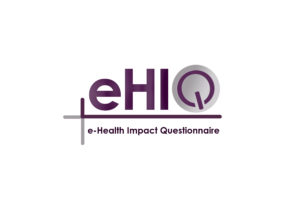The eHIQ was developed using a four stage process as outlined below.
Stage 1- Item generation
Items were informed through a review of relevant literature and secondary qualitative analysis of 99 patient / carer interviews representing a range of health conditions. Five themes were found to be applicable to the impact of using health-related websites: 1) Information, 2) Feeling supported, 3) Relationships with others, 4) Experiencing health services and; 5) Affecting behaviours. Questionnaire items were derived from this activity and shown for review to an expert panel consisting of clinicians and academics with interests in the field of e-health.
Stage 2- Cognitive de-brief interviews
Cognitive debrief interviews (n=21) were used to assess items for face and content validity. Cognitive interviewing confirmed:
- the instructions were easy to understand and the rubric clearly indicated how participants were supposed to answer items,
- participants found all items retained relevant to the topic and acceptable to answer,
- the response options were appropriate to the item stem and the response options adequately covered the potential range of agreement, and
- the electronic format was appropriate for use among a range of participants with varying levels of computer proficiency.
Items were deleted (n=29) and added (n=9), leaving 62 items.
Stage 3- Item reduction and scale generation
Following expert and patient refinement, two independent item pools were confirmed as suitable to enter psychometric testing. The first item pool contained 23 items asking respondents about their general attitudes towards health related websites whilst the second item pool contained 39 items asking the respondent about their attitudes towards a specific health related website. All items had a five point Likert response scale (Strongly disagree- Strongly agree).
The two part questionnaire was administered online to obtain a dataset with which to perform appropriate statistical and psychometric analysis. Open recruitment took place through advertised research invites on health related websites (for example, health blogs, online discussion forums, social networking sites (Facebook and Twitter), health websites news pages, health websites research volunteer pages, local news online advertisements, research and policy volunteer email list).
Items were subjected to preliminary data checks to ensure their suitability to proceed in the analysis. At this stage items were checked for floor and ceiling effects, with the result being that no items needed removal.
Items which had poor correlations (<0.2) with a large number of items, low item total correlations (<0.3) and items which reduced the Cronbach’s alpha value were identified resulting in the eHIQ-Part 1 being reduced to 14 items and the eHIQ-Part 2 reduced to 34 items.
Stage 4- Validity and reliability of questionnaire
The reduced eHIQ and appropriate reference measures were administered online to confirm domains present using exploratory factor analysis, to examine convergent validity and to test reliability, which resulted in:
- For eHIQ Part 1 the removal of three items and confirmed the presence of two domains, (1) Attitudes towards online health information and (2) Attitudes towards sharing health experiences online.
- For eHIQ part 2 eight items were removed and three domains were retained: 1) Confidence and identification, 2) Information and presentation and 3) Understanding and motivation.
Results confirmed expectations that the eHIQ domains were moderately related to reference measures of similar constructs. All domains showed good internal consistency achieving a Cronbrach’s alpha of ≥ 0.77. Good test-retest reliability was found among those who completed the eHIQ again after a two week interval (n=83). Intra-class correlation coefficients ranged from 0.76 to 0.91 for all domains.
^ Back to top




